
Arthur Hacker (1858-1919) stands as a significant figure in British art during the late Victorian and Edwardian periods. A painter of considerable versatility, he navigated the shifting artistic currents of his time, achieving success in genres ranging from historical and religious subjects to society portraiture and atmospheric depictions of modern life. His career reflects both an adherence to academic tradition and an engagement with newer artistic ideas emerging from France and within Britain. Elected a full member of the prestigious Royal Academy of Arts, Hacker left behind a body of work appreciated for its technical skill, emotional depth, and nuanced handling of light and colour.
Early Life and Artistic Formation
Arthur Hacker was born in St Pancras, Middlesex, London, in 1858. His artistic inclinations may have been nurtured early on, as his father, Edward Hacker (1812-1905), was a respected line engraver known particularly for his detailed prints of animals and sporting scenes. Beyond his artistic pursuits, Edward Hacker also held the position of Registrar of Births and Deaths for the Kentish Town sub-district, suggesting a family grounded in both creative skill and civic responsibility. This background likely provided young Arthur with an environment where art was valued and understood as a profession.
Seeking formal training, Hacker enrolled at the Royal Academy Schools in 1876, the premier institution for art education in Britain at the time. Here, he would have received a rigorous grounding in drawing, anatomy, and the principles of academic composition, following a curriculum shaped by figures like Frederic Leighton and Edward Poynter, successive Presidents of the Royal Academy during Hacker's formative years. This traditional training formed the bedrock of his technical proficiency.
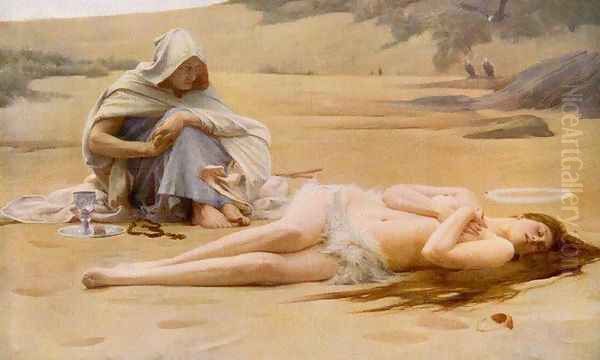
However, like many ambitious young British artists of his generation, Hacker sought further refinement and exposure to continental trends. Between 1880 and 1881, he travelled to Paris to study in the bustling atelier of Léon Bonnat. Bonnat was a highly successful portraitist and history painter, known for his robust realism and mastery of draughtsmanship, influenced by Spanish masters like Velázquez. Studying under Bonnat exposed Hacker directly to contemporary French academic methods and a more vigorous, less idealized approach to representation than often prevailed in London. This Parisian experience proved formative, broadening his technical skills and artistic outlook.
Establishing a Career: Realism and Early Success
Returning to London, Hacker began to establish his reputation. His early work showed an affinity for the detailed realism and narrative clarity associated with the Pre-Raphaelite Brotherhood, although he was of a later generation than founders like Dante Gabriel Rossetti, William Holman Hunt, and John Everett Millais. He was also keenly aware of the French rural naturalist movement, particularly the work of Jules Bastien-Lepage, whose influence permeated British art in the 1880s, encouraging plein-air (outdoor) painting and scenes of everyday rural life rendered with objective detail and often a subdued, tonal palette.
Hacker's engagement with these contemporary trends is evident in his early subject pictures. He became associated for a time with the burgeoning New Realist movement in Britain. Alongside fellow artist Stanhope Forbes, who had also studied under Bonnat in Paris and would become a leading figure of the Newlyn School in Cornwall, Hacker was involved in the founding of the New English Art Club (NEAC) in 1886. The NEAC was established by artists seeking exhibition venues outside the perceived conservatism of the Royal Academy, often championing French-influenced realism and Impressionistic techniques. Hacker exhibited works like Cradle Song (1886) at the NEAC, marking his early alignment with this progressive group.
His painting Pelagia and Philammon (1887), depicting a scene from Charles Kingsley's novel Hypatia, garnered significant attention. Exhibited at the Grosvenor Gallery, it showcased his ability to handle complex compositions, render the human form with sensitivity, and create a poignant atmosphere. The work, now housed in the Walker Art Gallery, Liverpool, demonstrates his skill in combining historical narrative with a realistic treatment, particularly evident in the depiction of the female nude, a subject he would return to throughout his career. Another notable work from this period is By the Waters of Babylon (1888), now in the Rochdale Art Gallery, further cementing his reputation for tackling serious historical and biblical themes.
Artistic Style: A Blend of Traditions
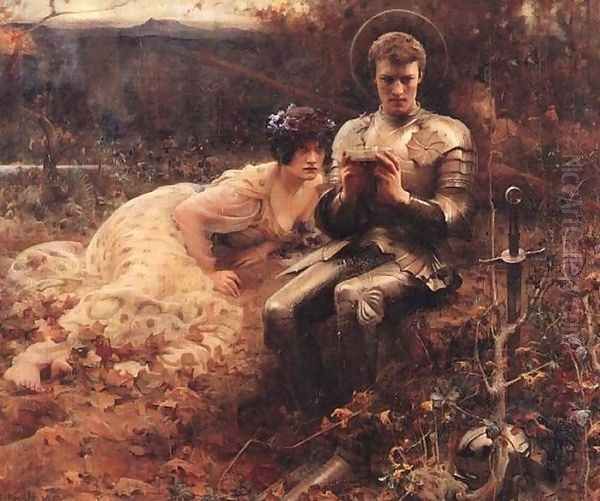
Arthur Hacker's style is characterized by its synthesis of different artistic approaches. Rooted in the academic training of the Royal Academy and Bonnat's atelier, his work consistently displays strong draughtsmanship and compositional structure. However, he infused this traditional base with elements drawn from contemporary movements, resulting in a distinctive and evolving aesthetic.
The influence of the Pre-Raphaelites can be seen in the clarity, detail, and sometimes melancholic or symbolic mood of certain works, particularly those with historical or literary themes like The Temptation of Sir Percival (1894). This painting, depicting a scene from Arthurian legend, echoes the medievalism and moral seriousness found in earlier Pre-Raphaelite art, though rendered with Hacker's own softer modelling and atmospheric handling.
His time in France and association with the NEAC brought the influence of French Realism and plein-air painting into his work. This is evident in his attention to natural light effects and often a more muted, tonal colour palette, especially in his landscapes and genre scenes. He became adept at capturing atmosphere, whether the quietude of a domestic interior or the specific quality of outdoor light. Works like Dutch Harbours show his capacity for sensitive observation of landscape and seascape, rendered with a concern for accurate light and tone.
Impressionism also left its mark, particularly in his handling of light and colour in certain passages. While not an Impressionist in the French sense – he rarely dissolved form completely into light and brushwork – he clearly absorbed lessons about capturing fleeting effects and using colour more vibrantly to suggest light and shadow. This is especially noticeable in his later works, where his brushwork could become looser and more expressive. His ability to modulate light, creating subtle transitions and dramatic contrasts, became a hallmark of his style across different genres.
Religious, Mythological, and Historical Themes
A significant portion of Hacker's output was dedicated to religious, mythological, and historical subjects. These grand narrative paintings were highly regarded in the late Victorian and Edwardian eras and offered artists a platform to display their technical virtuosity and interpretive skills. Hacker excelled in this arena, creating works that were both visually compelling and emotionally resonant.
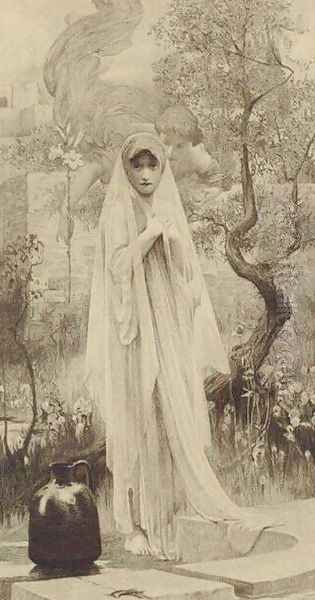
His painting The Annunciation (1892) was a major success. Purchased for the nation under the terms of the Chantrey Bequest – a fund administered by the Royal Academy to acquire important works of British art – its acquisition signified official recognition at the highest level. The painting depicts the biblical scene with a blend of realism and ethereal light, focusing on the Virgin Mary's humble and contemplative reaction. The sensitive portrayal of emotion and the masterful handling of light filtering into the simple interior space are characteristic of Hacker's strengths.
Mythological themes also provided fertile ground for Hacker. The Syrinx (date uncertain) depicts the nymph Syrinx transforming into reeds to escape the god Pan. Such subjects allowed for the depiction of the idealized nude figure within a classical narrative context, a popular genre among academic painters like Frederic Leighton and Lawrence Alma-Tadema. Hacker approached these themes with a characteristic sensitivity, often focusing on the psychological state of the figures.
His historical paintings, such as Pelagia and Philammon, often explored moments of human drama and moral complexity. He drew inspiration from literature, history, and legend, creating compositions that invited viewers to contemplate the narrative and the emotions involved. These works placed him firmly within the tradition of British subject painting, alongside contemporaries like John William Waterhouse and Frank Dicksee, who also specialized in romantic and historical scenes.
Success in Portraiture
Alongside his subject pictures, Arthur Hacker built a highly successful career as a portrait painter. This became an increasingly important part of his practice, providing a steady income and allowing him to engage with the prominent figures of his day. His academic training and refined technique made him well-suited to the demands of commissioned portraiture, which required not only a good likeness but also a sense of dignity and character.
His portraits are noted for their psychological insight and sensitive rendering. He moved beyond mere surface likeness to capture something of the sitter's personality and inner life. His handling of light and shadow played a crucial role here, often used to model the face subtly and create a particular mood. His female portraits, such as Mrs. R.E. Hoare (1890), were particularly admired for their elegance and sympathetic portrayal.
In the competitive London art world, Hacker's portraits held their own against those by celebrated contemporaries like John Singer Sargent and James McNeill Whistler, as well as fellow Royal Academicians such as Hubert von Herkomer and Luke Fildes. While perhaps less flamboyant than Sargent, Hacker offered a solid, perceptive, and often more introspective style of portraiture that appealed to many patrons. His success in this field contributed significantly to his standing within the art establishment.
Later Career, London Scenes, and Recognition
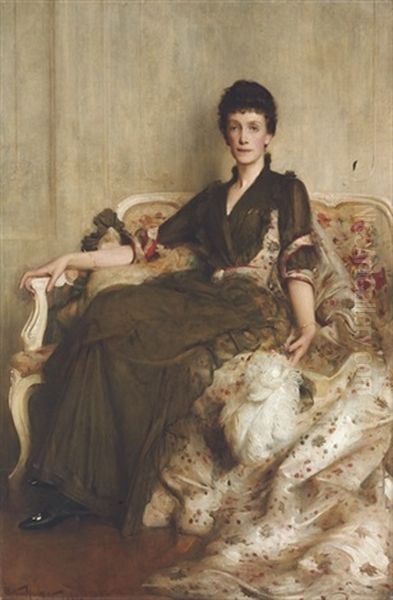
By the 1890s, Hacker's reputation was firmly established. He was elected an Associate of the Royal Academy (ARA) in 1894, a significant step towards full membership. Although initially associated with the more rebellious NEAC, Hacker, like some other artists of his generation, gravitated back towards the Royal Academy, which remained the most prestigious venue for exhibition and professional advancement in Britain. His election as a full Royal Academician (RA) followed in 1910, confirming his status within the highest echelons of the British art world.
In his later career, Hacker continued to produce portraits and subject pictures, but he also explored new themes and stylistic approaches. Around 1910, he began a series of paintings depicting London street scenes at night or in inclement weather. Works like A Wet Night at Piccadilly Circus (c. 1910) marked a departure, tackling modern urban subjects with a looser, more atmospheric technique that showed an awareness of Post-Impressionist aesthetics. These paintings captured the fog, rain, and artificial lights of the city, conveying the dynamism and sometimes alienating quality of modern life. Their style and subject matter were considered quite contemporary, even somewhat controversial by academic standards, demonstrating Hacker's willingness to continue evolving as an artist.
His travels also continued to inform his work. Trips to Spain, Morocco, Algeria, and Tunisia provided inspiration, likely influencing his palette and his interest in strong light effects and exotic subjects, echoing the Orientalist interests of painters like Jean-Léon Gérôme, though Hacker's interpretations were generally less overtly dramatic.
Personal Life and Legacy
In his personal life, Hacker achieved a degree of stability and comfort commensurate with his professional success. In 1907, he married Lilian Price Edwards (1879-1948), who was herself an artist, suggesting a shared world of creative interests. In 1898, some years prior to his marriage, he had purchased Hall Inge, a country house near Heathfield in Sussex, which he reportedly decorated himself, indicating an interest in design and the creation of a pleasant domestic environment.
Arthur Hacker died relatively young, passing away in London in November 1919 at the age of 61. He was buried in Brookwood Cemetery, Surrey. By the time of his death, the art world was already undergoing radical changes with the advent of modernism, and the academic and narrative styles Hacker largely represented were falling out of critical favour. However, his contribution remains significant.
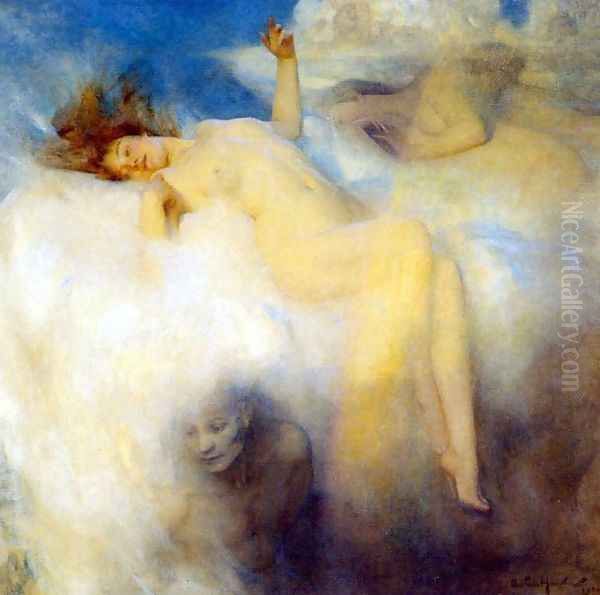
His work is held in numerous public collections in the UK, including the Tate Britain, the Walker Art Gallery in Liverpool, the Atkinson Art Gallery in Southport, Leeds Art Gallery, and the Royal Academy itself. These collections preserve examples of his diverse output, from large-scale subject pictures to intimate portraits and atmospheric landscapes.
Arthur Hacker's legacy lies in his position as a highly skilled and adaptable painter who successfully navigated the complex art world of late Victorian and Edwardian Britain. He absorbed influences from various sources – academic tradition, Pre-Raphaelitism, French Realism, and Impressionism – forging a style that was both accomplished and personal. He excelled in multiple genres, producing works of technical brilliance and emotional depth. While perhaps overshadowed in art history by more revolutionary figures, Hacker represents the strength and versatility of British painting during his era, bridging the gap between established traditions and the emerging currents of modern art. His contemporaries included a wide range of artists, from the academic establishment figures like Leighton, Poynter, and Alma-Tadema, to realists like Forbes and Henry Scott Tuke, portraitists like Sargent and William Orpen, and narrative painters like Waterhouse and George Frederic Watts, placing Hacker firmly within the rich tapestry of British art at the turn of the twentieth century.